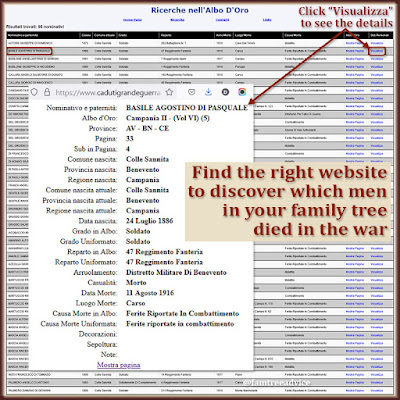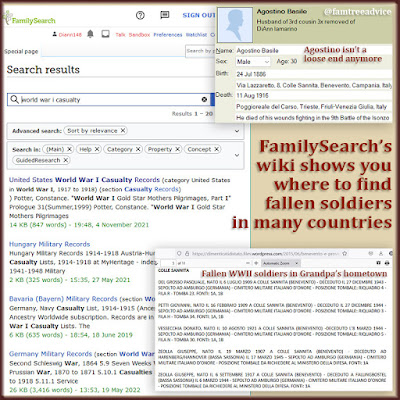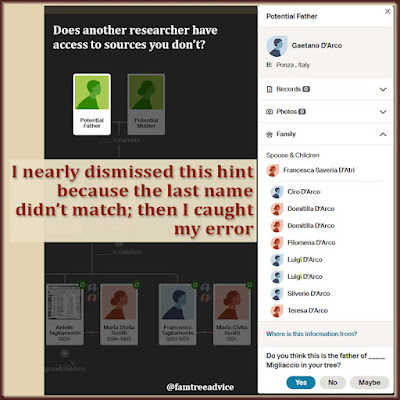My second grade teacher taught us to read by making us "sound it out." I remember my class sounding out a sentence in one voice. "We went to the park" sounded like: wuh ee, we; wuh en t, went; tuh oo, to; thuh uh, the; puh arr k, park." It sounded weird, but it worked.
That lesson from too many decades ago helped me break down a family tree brick wall last week.
There's an Italian-American woman who wants to visit her ancestral hometowns. She wants to identify her ancestors so she might connect with people in the towns. One branch of her tree was giving me problems. I couldn't be sure where this particular husband and wife came from, and my searches were coming up empty.
Then she shared a family history that her ancestor wrote about this brick wall branch. The document had exact birth dates for the couple. It listed 2 or 3 hometowns for both the husband and wife. That was curious. Then again, it could mean that they were born in one town and their parents were born somewhere else.
I focused on the husband first. I checked a website that lists the names of every town in Italy. Of the 3 hometowns in the family history document, only one existed. I did not find him there.
The other 2 towns did not exist, and the spelling didn't look like proper Italian. I figured this was how the town sounded to the family history author when her ancestor said it. This was a phonetic spelling of the town.
Say It, Don't Spell It
With that in mind, I kept saying the 2 misspelled town names aloud, over and over again. I scanned the list of Italian towns as I repeated the sounds again and again. I didn't find them.
 |
| You may not know how to spell the name of your ancestor's town. What to do? Sound it out. |
One of the best methods for finding a hometown is to find your ancestor on a ship manifest. I knew I wouldn't find the hometown on his ship manifest because he came to America too early. My ancestors were kind enough not to arrive before 1898, giving me a good look at the names of their hometowns.
The family history document had one more good clue about this couple. They got married in Manhattan in about 1888. I went straight to the search page for the New York City Municipal Archives. I knew I should find the marriage document there. I hoped it would have the bride and groom's parents' names. I did not expect it to list a hometown.
My searches failed. I couldn't find this couple, even when I included all the city's boroughs and expanded the years. Then I searched for a variation of the bride's last name. Experience tells me that an Italian last name ending in i usually ended in o at an earlier time. So I searched for her name ending in an o. This produced a long list of possibilities. I looked at the search results, hoping to find one with both her name and his.
That's when I found them. I never thought a clerk would misspell his very common last name. I swear, the NYC clerks in the late 1800s were illiterate. Who spells Italy Ytali? Someone who hears an Italian pronounce Italy and can't spell, that's who.
See How It Sounds
Now I had my couple's parents' names, even though the clerk mangled each one. (Saverio is a first name. Saviero is not.) Since the groom's mother's name was not common, I did an Ancestry search for her. The one search result made me gasp. (I guess I'm a gasper.) It was someone else's family tree that included my groom's entire family—but not him.
Everything about this unsourced tree made perfect sense to me. The parents matched the NYC marriage record. The family history mentioned the groom's sister and brothers, and here they were. I never accept someone's family tree as fact, but I was able to verify what they were showing.
The one thing that made me certain this was the right family was their hometown. Remember those misspelled town names? The ones I kept saying aloud to hear their sound? This tree had one of the town names. When I said it aloud, I knew for a fact it was the misspelled town from the document.
 |
| Keep sounding out that foreign town name as you search for something that matches the sound. |
Now it was time to prove this person's tree right or wrong. I searched the properly spelled town for my groom's birth record. I found him in the year before the date from the family history. (Always assume early ancestors may not know their own birthday.) There he was with the same parents I'd found misspelled on his NYC marriage record.
Knowing the right town, I used vital records to take the groom's family back 4 generations!
Most people would see that other family tree and think, "That's not the town great grandpa used to talk about." But I saw the town name and said it aloud as an Italian would. I heard it as a match for the botched spelling in the family history document.
When you pronounce an R in Italian, it sounds like a D. My grandfather used to call my grandmother Mary something that sounded like Moddy. That wasn't a D sound. It was a rolled R. That's why the family history had the town name so wrong.
What Else Makes That Sound?
My second grade teacher's "sound it out" method is still working for me. Have you heard your ancestor's hometown spoken with a foreign accent but never saw it written? You may not know how to spell it at all.
I used this method in my own family tree once before. (See Case Study on "What If There's No There There?") My great grandmother used to talk about where she came from. Her granddaughter passed that along to me as a phonetic spelling: Pisqualamazza. That's not a town. So I searched passenger lists for anyone around her age with her last name. I looked at each search result to see the hometown. When I saw Pescolamazza, I knew that was it. And that's where I found her birth record. Now I can name her 3rd great grandparents.
If you can't locate your ancestral hometown, keep your mind and ears open. Sound it out as you try to mimic the right accent. If you heard your grandfather say it when you were a kid, try to remember exactly how it sounded. Then see what sounds the same.






